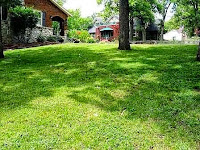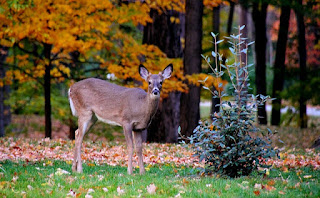If you have a small yard or live in an apartment with a balcony, terrace, or deck then a container will allow you to enjoy gardening. Containers come in a variety of sizes and shapes, some large and others are small, there is a perfect size container for your gardening needs.
I like to plant container gardens that will last more than one season. In the fall I will plant an assortment of spring bulbs and then on top of the bulbs I will plant close to the soil surface an assortment of winter hardy pansies, with Baltic ivy cascading down the sides.
This autumn container will provide color and interest at the entrance of my home and will look good until the weather turns bitter cold.When winter comes I will add cut branches of balsam greenery for filler, red holly berries for color, eucalyptus branches and branches of wild nandina berries for interest. Sometimes I use honeysuckle vines, and pine cones. I fill the containers up with evergreens so that I can look out and see beautiful greenery during the winter season. The possibilities are endless for creating a seasonal container garden. All you need is to think outside the box and be creative.
Photographs of Container
Gardens:
A container garden
will add color, and interest to your home, patio, and garden. Here are some tips for planting and growing
container gardens. If you have any
additional questions please leave me a comment.
Seasonal
Container Gardening Questions and Answers:
When is the best time to plant a container garden?
When is the best time to plant a container garden?
Plant your container
garden after the danger of a spring frost has passed or plant it 6 weeks before a
hard frost.
What seasonal plants are best for container gardens?
Choose from a variety
of annual and perennial plants that have the same growing requirements. In spring you may
want to grow bulbs; crocus, hyacinths, daffodils, or tulips, in summer perennial and annual flowers, herbs, or vegetables.
In the fall season, I like copper or dark chocolate coleus, bayberry, ornamental grass, ornamental purple cabbage, dwarf yellow lantana, or purple or coral heuchera.
Choose plants that tell a color story. Look for flowers that are a contrast to your container. If your container is black then you may want to choose a green plant like the sweet potato vine that will cascade down the sides of the container, dwarf yellow lantana, and pink variegated coleus. These plants will make a black container pop.
There are many plants that you can grow in a container, choose plants that will complement each other and are eye appealing.
In the fall season, I like copper or dark chocolate coleus, bayberry, ornamental grass, ornamental purple cabbage, dwarf yellow lantana, or purple or coral heuchera.
Choose plants that tell a color story. Look for flowers that are a contrast to your container. If your container is black then you may want to choose a green plant like the sweet potato vine that will cascade down the sides of the container, dwarf yellow lantana, and pink variegated coleus. These plants will make a black container pop.
There are many plants that you can grow in a container, choose plants that will complement each other and are eye appealing.
Are
drainage holes important?
Check your container
for proper drainage holes. Turn the pot over and look for holes. Proper
drainage is important because your plants will die if the roots are in wet
soil. If you do not have drainage holes then you need to make them.
For plastic or wood window boxes use a drill to make drainage holes.
How to get containers ready for planning?
If you are reusing a container then you must clean it to protect the new plants from disease. Remove the soil, then clean the container by mixing equal parts of bleach and hot water. Dip a wire brush into the cleaning solution and then scrub the inside of the container. Rinse the container with water from your garden hose and allow it to dry well before using it.
How to get containers ready for planning?
If you are reusing a container then you must clean it to protect the new plants from disease. Remove the soil, then clean the container by mixing equal parts of bleach and hot water. Dip a wire brush into the cleaning solution and then scrub the inside of the container. Rinse the container with water from your garden hose and allow it to dry well before using it.
What
soil is best for a container garden?
Fill the container
with Miracle-Gro moisture control potting soil. This special formula soil is perfect for container gardens because it protects the plants from overwatering and underwatering.
Container garden design tips:
Container garden design tips:
Keep the containers
bright and cheerful and use no more than 4 types of plants in a container. Choose a feature plant for the center, this plant is a tall plant like fountain grass, then add medium-sized plants around the fountain grass, the medium plants are the filler plants, you can add a few vines that will cascade down the sides; sweet potato or ivy are nice and will add interest to the container.
Caring
for Container Plants
- Water your container plants in the early evening by watering at the soil line. Water until it drains out the bottom of the pot. Container plants dry out quickly and if the soil is dry the plant will wilt. A wilting plant is a sign of stress. It is best to keep the soil in the container evenly moist, not wet. Watch your container gardens and if they need water, or the soil feels dry then water them.
- Stop watering when the water drains from the bottom of the container as this is an indication that the water has reached all of the roots.
- Fertilize your gardens once a week with a liquid fertilizer that will boost the blooms.
- Apply a layer of mulch or moss around the plants to help to retain moisture.
- Use a saucer under your container to protect your patio or deck from water stains.
January is a good time to plan an indoor container garden. You can grow any plant indoors as long as you provide the plants with sun, heat, and water. If you have a southern exposure window then set your container close to this heat source. If not then buy an artificial grow light. An indoor container garden is a perfect size for vegetables, flowers, or greenery. View this YouTube video for some ideas:




